The Philippine Statistics Authority (PSA) reports the latest palay production and harvested area estimates for Northern Samar in the first quarter of 2025, based on data gathered from the Palay and Corn Production Survey (PCPS). This quarterly survey provides comprehensive statistics on production volume, yield per hectare, and total area harvested for both palay and corn, serving as a vital input for agricultural planning and policy-making.
In the first quarter of 2025, Northern Samar recorded a palay production volume of 39,896 metric tons, showing a slight decrease compared to the 39,897 metric tons produced in the same quarter of 2024. This reflects a year-on-year decrease of 1 metric ton. This minimal decline suggests that production remained stable year-on-year, with no significant change in output levels.

Figure 1 shows that Northern Samar recorded a total palay production of 39,896 metric tons, reflecting a year-on-year decrease of 1 metric ton compared to the 39,897 metric tons produced during the same period in 2024. This minimal decrease indicates relatively stable production conditions in the province. Furthermore, irrigated palay production decreased from 3,918 metric tons in the first quarter of 2024 to 3,915 metric tons in the same quarter of 2025, posting a decrease of 3 metric tons or 0.08 percent. Whereas, rainfed palay production showed a slight increase, rising from 35,979 metric tons to 35,981 metric tons, equivalent to a 2-metric ton increase.
The data indicates that palay production in Northern Samar remained steady in the first quarter of 2025. The minor shifts between irrigated and rainfed outputs suggest localized adjustments rather than wide systemic changes, reflecting the province's general resilience and consistency in rice farming.
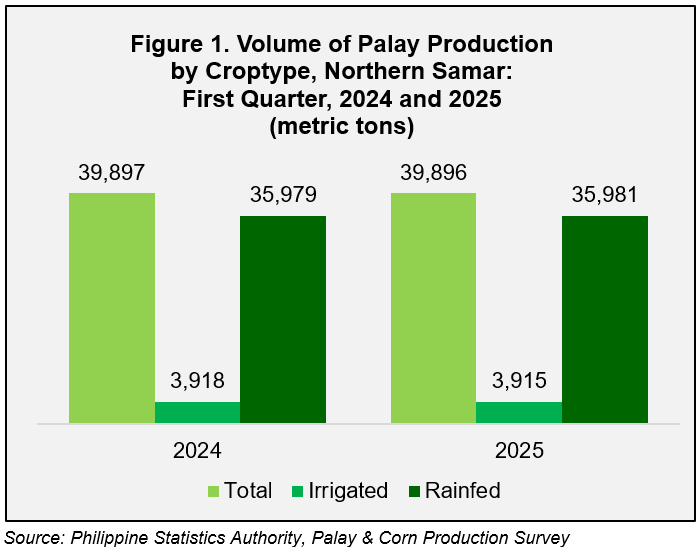
Moreover, figure 2 presented that Region VIII (Eastern Visayas) recorded a total palay production of 240,529.90 metric tons, reflecting the region’s continued contribution to the country's rice supply. Among the provinces, Leyte registered the top producer with 126,881.15 metric tons, covering for about 52.75 percent of the region's total output. This was followed by Northern Samar, which contributed 39,896 metric tons or around 16.59 percent, and Samar with 36,232.35 metric tons or 15.06 percent. Eastern Samar produced 22,585 metric tons, while Southern Leyte at 8,455.40 metric tons and Biliran reported total palay production of 6,480 metric tons contributing 2.69 percent of region’s total production.
The data reflects a concentration of palay production in Leyte, with over half of the region’s rice from this province. Northern Samar and Samar also contribute significantly. This distribution suggests potential areas for targeted investment or support to boost production capacity in lower-contributing provinces.
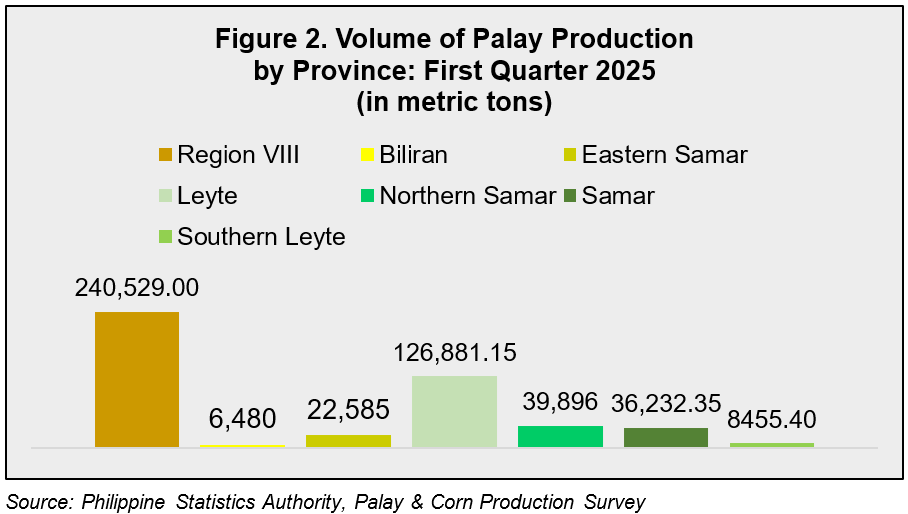
Figure 3 presented that the total area harvested for palay in Northern Samar slightly increased compared to the same period in 2024. The total area harvested increased from 15,167 hectares to 15,189 hectares, reflecting a year-on-year growth of
22 hectares or 0.15 percentage increase.
The area harvested for irrigated palay increased from 1,450 hectares in First Quarter 2024 to 1,457 hectares in the same period of 2025, marking a 0.48 percent increase. This increase may indicate improvements in irrigation infrastructure or more favorable water availability during the period. While, the area harvested for rainfed palay increased at 13,732 hectares from 13,717 hectares in 2024 posting 0.11 percent increase.
The increases in both irrigated and rainfed palay areas indicate stable to slightly improving conditions for rice cultivation in the province. While the changes are relatively small, they suggest ongoing efforts or natural improvements that support the sustainability of local rice production.
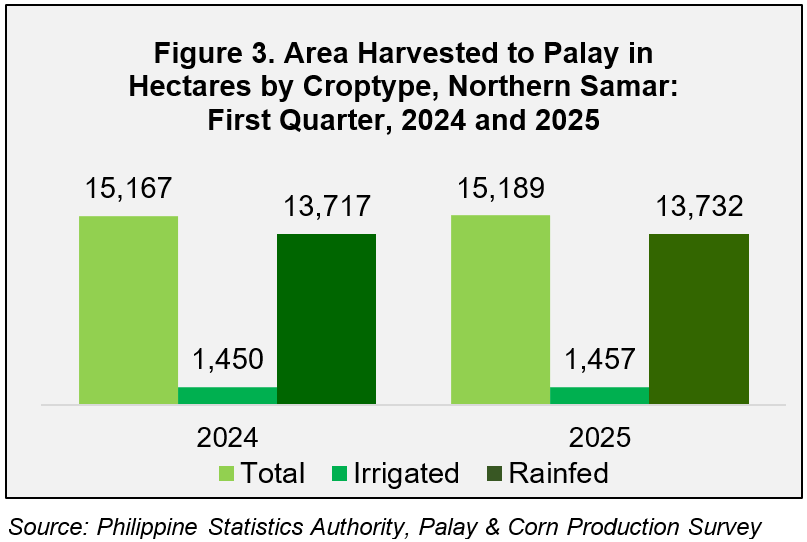
The data from the first quarter of 2025 shows that palay production in Northern Samar has remained stable and strong. Even though there was a very small decrease of just 1 metric ton compared to the same period last year, overall production levels were steady. This suggests that rice farming in the province continues to perform well under mostly stable conditions.
In summary, the small changes in both irrigated and rainfed palay production seem to be the result of local factors, such as variations in water availability or farming practices, rather than any major issues. These changes indicate to a rice farming system that is steady and capable of supporting sustainable agriculture in the province.
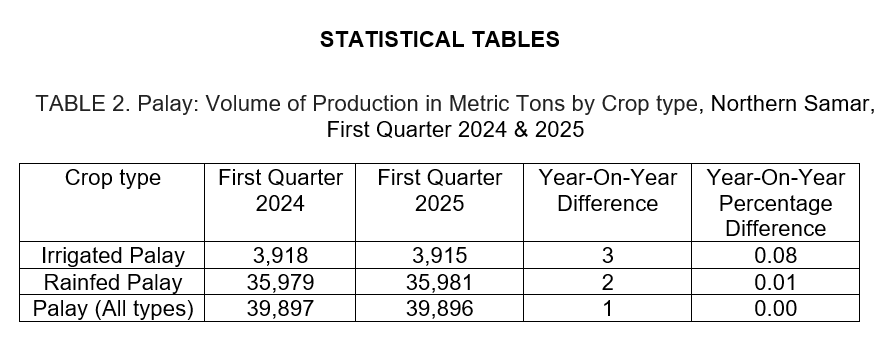
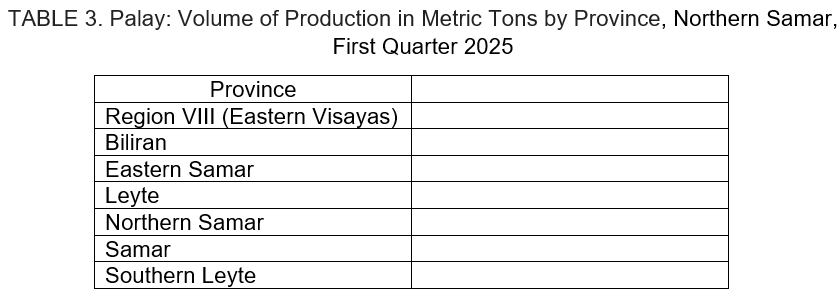

TECHNICAL NOTES
Palay production, area and yield and other production data are generated from Palay Production Survey (PPS) which is one of the major agricultural surveys of the Philippine Statistics Authority (PSA). The PPS is conducted nationwide every quarter of each year. It aims to generate estimates that serve as inputs for policy making and programs on palay. Production data generated from the PPS are inputs to the Performance of Agriculture Report (PAR) and preparation of the Gross Domestic Product (GDP).
• Palay - refers to the local term for unhulled rice; also known as paddy or rough rice; scientifically called Oryza Sativa Linn.
• Production – refers to quantity produced and actually harvested during reference period. It includes those harvested but damaged, stolen, given away, consumed, given as harvesters’ and threshers’ shares, reserved, etc. Palay production from seed growers which are intended for seed purposes is excluded from the survey.
• Irrigated – area with irrigation facilities supplying water through artificial means like gravity, force/power, pump, etc. Irrigated area become rainfed only, when the irrigation system is no longer operational for the past two (2) years and beyond repair and there is no plan of irrigating the farm.
• Rainfed – palay grown on this ecosystem has dikes to retain water and is solely dependent on rainfall for its water supply. Rainfed can be converted to irrigated only if area is laid with permanent irrigation facilities.
MARIA THERESA G. ELIZALDE (SGD.)
Chief Statistical Specialist

